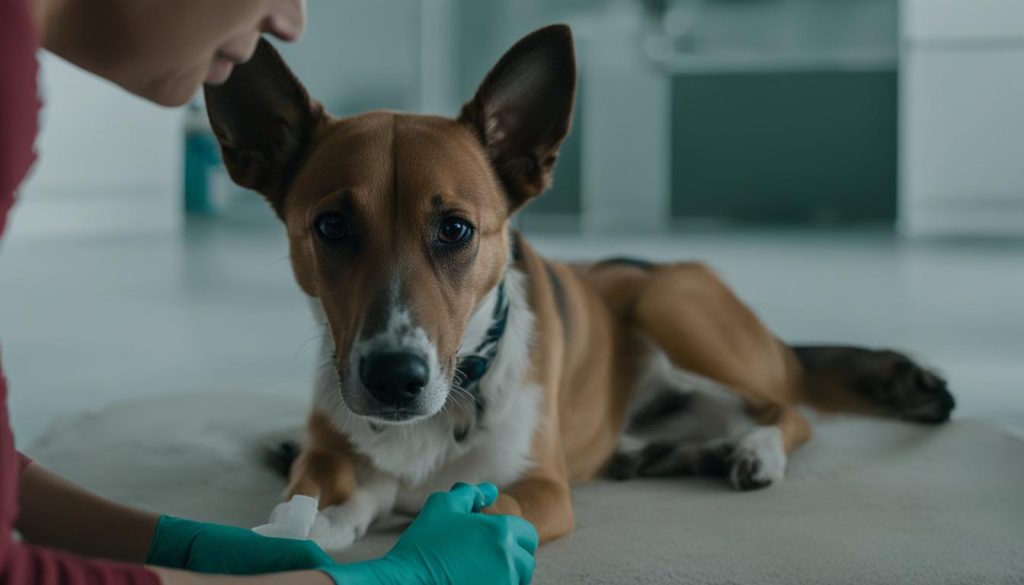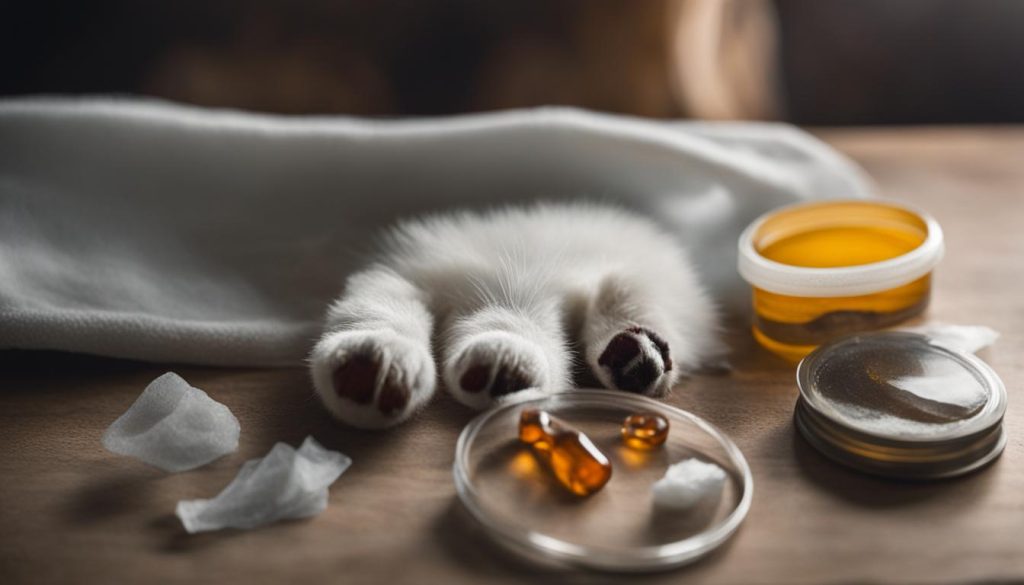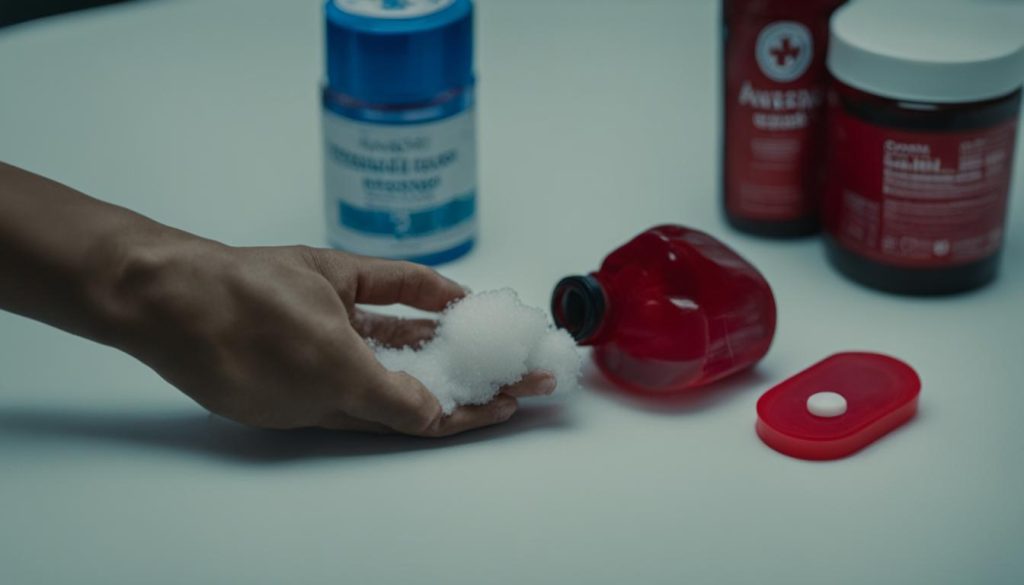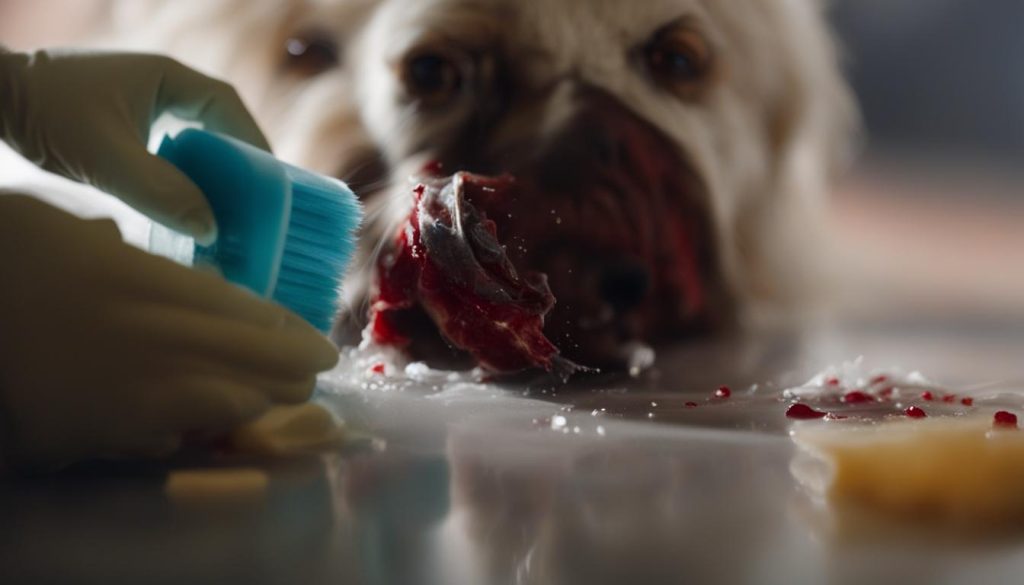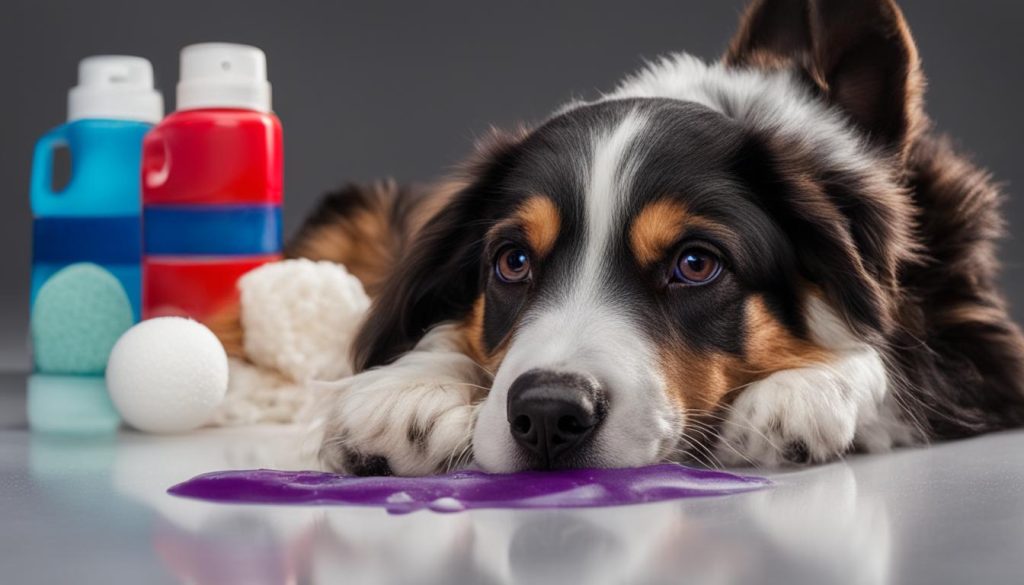A dog wound can be a distressing situation for pet owners. Whether it’s a cut, bruise, or any other type of injury that damages the skin and underlying tissues, proper disinfection is crucial for promoting healing and preventing infection. In this section, you will learn how to effectively disinfect a dog wound to ensure your furry friend’s well-being.
Key Takeaways:
- Disinfecting a dog wound is essential to prevent infection and promote healing.
- Avoid applying ointments or disinfectants without veterinary guidance.
- Know when to seek veterinary attention for dog wounds that require professional care.
- Proper supplies like clippers, lubricant, warm water, antiseptic solution, and antibiotic ointment are necessary for home wound care.
- Follow the steps for cleaning and treating dog wounds at home, ensuring proper restraint and monitoring for signs of infection.
When to Seek Veterinary Attention for Dog Wounds
In certain cases, dog wounds require immediate veterinary attention. It is crucial to be aware of these situations to ensure proper care and prevent further complications. Here are some instances when seeking veterinary attention for dog wounds is necessary:
- If the wound fully penetrates the skin or involves a large portion of the body, it may require professional treatment.
- Wounds in sensitive areas, such as the eyes, ears, or genitals, should always be examined by a veterinarian.
- If the wound shows signs of infection, such as pus, redness, or swelling, it is important to consult a veterinarian for appropriate treatment.
- Severe wounds that do not appear to heal on their own within a reasonable time frame should be evaluated by a professional.
Remember, prompt veterinary attention is crucial to prevent infection and ensure proper healing for your dog’s wounds. It is always better to err on the side of caution and seek professional advice when in doubt.
Table: Situations Requiring Veterinary Attention for Dog Wounds
| Situation | When to Seek Veterinary Attention |
|---|---|
| Full penetration or large wounds | If the wound fully penetrates the skin or involves a large portion of the body, it may require professional treatment. |
| Wounds in sensitive areas | Wounds in sensitive areas, such as the eyes, ears, or genitals, should always be examined by a veterinarian. |
| Signs of infection | If the wound shows signs of infection, such as pus, redness, or swelling, it is important to consult a veterinarian for appropriate treatment. |
| Non-healing severe wounds | Severe wounds that do not appear to heal on their own within a reasonable time frame should be evaluated by a professional. |
By recognizing the situations that require veterinary attention, you can ensure that your dog receives the necessary care and treatment for its wounds. Always consult a veterinarian for expert advice and guidance in these cases.
Supplies Needed for Dog Wound Care at Home
When it comes to effectively cleaning and treating a dog’s wound at home, having the right supplies is crucial. Here are the essential items you will need:
- Electric clippers or scissors to remove hair around the wound
- Water-based lubricant for easier hair removal
- Warm water to flush the wound
- Clean towels for drying
- Antiseptic solution for rinsing
- Antimicrobial ointment for applying to the wound
Having these supplies on hand will ensure that you can provide proper wound care and help prevent infection. Before starting the process, make sure you have everything you need within reach.
It’s important to note that not all wounds can be treated at home, and some may require veterinary attention. If you are unsure about the severity of your dog’s wound or if it shows signs of infection, it’s best to consult with a veterinarian for guidance.
| Supply | Purpose |
|---|---|
| Electric clippers or scissors | To remove hair around the wound |
| Water-based lubricant | For easier hair removal |
| Warm water | To flush the wound |
| Clean towels | For drying |
| Antiseptic solution | For rinsing |
| Antimicrobial ointment | To apply to the wound |
Having these supplies readily available will make the process of cleaning and treating your dog’s wound at home more convenient and efficient. Remember to always prioritize your dog’s safety and well-being when administering any type of wound care.
Steps for Cleaning and Treating Dog Wounds at Home
When it comes to cleaning and treating dog wounds at home, following the correct steps is essential for the wellbeing and recovery of your furry friend. By providing prompt and effective care, you can minimize the risk of infection and ensure proper healing. Here, I will outline the step-by-step process for cleaning and treating dog wounds at home, giving you the confidence to take care of your pet in times of need.
Step 1: Restrain and Calm Your Dog
Before you begin cleaning the wound, it is important to gently restrain your dog and create a calm environment. This will help to reduce stress and prevent any accidental injuries. If necessary, you can use a muzzle to ensure safety during the process.
Step 2: Remove Hair Around the Wound
Using electric clippers or scissors, carefully remove the hair around the wound. This step is crucial as it prevents contamination and allows for better visibility and access to the wound. Apply a water-based lubricant to make the hair removal process easier and more comfortable for your dog.
Step 3: Cleanse the Wound
Next, flush the wound with warm salt water to cleanse it thoroughly. This helps to remove any debris, bacteria, or contaminants that may be present. Gently pour the salt water over the wound and ensure that it is well-flushed. Pat the area dry with a clean towel.
Step 4: Apply Antiseptic Solution and Ointment
After cleansing the wound, apply a non-stinging antiseptic solution to disinfect the area. This solution helps to kill bacteria and prevent infection. Once the antiseptic solution has dried, apply an antimicrobial ointment to the wound. This ointment provides a protective barrier and aids in the healing process.
By following these steps, you can effectively clean and treat dog wounds at home. However, it is important to monitor the wound closely for any signs of infection or worsening condition. If the wound does not improve within a reasonable time frame or shows signs of infection, it is advisable to seek veterinary attention for further evaluation and treatment.
When to Take Your Dog to the Vet for Wound Care
If your dog’s wound worsens, shows signs of infection, or fails to heal within a week, it is important to seek veterinary care. Signs of infection include a bad smell or discharge that is yellow, green, or gray. A veterinarian can provide proper evaluation and treatment, including stitches for deep wounds, drainage or debridement if needed, and systemic antibiotics to prevent or treat infection.
Proper wound care is crucial for your dog’s health and well-being. While many minor wounds can be treated at home, it is important to recognize when veterinary attention is necessary. Taking your dog to the vet ensures that any underlying issues are properly addressed and reduces the risk of complications. It is always better to err on the side of caution and seek professional help, especially when dealing with more severe or persistent wounds.
- If your dog’s wound is deep or does not stop bleeding after applying pressure
- If the wound is in a sensitive area, such as near the eyes, mouth, or genitals
- If you notice signs of infection, such as redness, swelling, pus, or a foul odor
- If the wound is not healing or seems to be getting worse
Remember, your veterinarian has the expertise and resources to properly assess and treat your dog’s wound. They will be able to determine the best course of action and provide the necessary care to ensure a full recovery. Trusting their professional judgment will help you provide the best possible care for your furry friend.
How to Prevent Wounds from Closing Too Early
When it comes to dog wound care, preventing wounds from closing too early is essential for proper healing. Closing too quickly can trap bacteria and debris inside the wound, leading to infection and complications. Here are some important tips to ensure wounds stay open and can heal effectively:
- Gently massage the surrounding skin: When cleaning the wound, gently massage the skin around it. This promotes drainage and helps prevent the wound from closing prematurely.
- Use warm water or saline solution: To clean the wound, use warm tap water or a saline solution. Avoid using soaps, shampoos, or other products without veterinary instruction.
- Monitor for signs of infection: Keep a close eye on the wound for any signs of infection such as redness, swelling, or discharge. If you notice anything unusual, contact your veterinarian.
- Seek veterinary guidance if needed: If you’re unsure about the care of your dog’s wound or if it’s not healing as expected, don’t hesitate to seek veterinary guidance. A professional can provide further advice and assistance.
Remember, each wound is unique, and proper wound care may vary based on the specific situation. Always follow your veterinarian’s instructions and consult them if you have any concerns or questions regarding your dog’s wound.
| Signs of Infection | Description |
|---|---|
| Redness | The wound appears increasingly red and inflamed. |
| Swelling | The area around the wound becomes swollen. |
| Heat | The wound feels warm to the touch. |
| Discharge | Yellow, green, or foul-smelling discharge is present. |
| Pain | Your dog shows signs of discomfort or pain when the wound is touched. |
| Fever | Your dog has an elevated body temperature. |
The Importance of Properly Disinfecting Dog Wounds
Properly disinfecting dog wounds is crucial to prevent infection and promote healing. When it comes to cleaning most wounds, warm tap water or saline solution is recommended. Avoid using soaps, shampoos, rubbing alcohol, hydrogen peroxide, or any other products unless specifically instructed by a veterinarian. These products can delay healing or be toxic if ingested. Instead, use antiseptic solutions like Betadine or Chlorhexidine for final rinsing to ensure effective disinfection. Applying antibiotic ointments to the wound can further prevent or treat infection.
It’s important to note that not all wounds can be treated at home. If a wound worsens, shows signs of infection, or fails to heal within a week, it is crucial to seek veterinary care for proper evaluation and treatment. Signs of infection include a bad smell or discharge that is yellow, green, or gray. A veterinarian can provide the necessary care, including stitches for deep wounds, drainage or debridement if needed, and systemic antibiotics to prevent or treat infection.
Properly disinfecting dog wounds is vital to ensure the best possible outcome for wound care. By following proper disinfection protocols and seeking veterinary attention when necessary, you can help your dog heal effectively and avoid potential complications.
Tips for Proper Disinfection:
- Use warm tap water or saline solution for cleaning
- Avoid using soaps, shampoos, rubbing alcohol, hydrogen peroxide, or other products unless directed by a veterinarian
- Use antiseptic solutions like Betadine or Chlorhexidine for final rinsing
- Apply antibiotic ointments to the wound to further prevent or treat infection
By following these proper disinfection guidelines, you can ensure effective wound care for your dog and support their healing process.
The Do’s and Don’ts of Dog Wound Disinfection
When it comes to disinfecting dog wounds, following the right practices is essential to promote healing and prevent further complications. Here are the do’s and don’ts you should keep in mind:
Do:
- Use warm tap water or saline solution to clean the wound. These solutions are gentle and effective in removing dirt and debris without causing further irritation.
- Use antiseptic solutions like Betadine or Chlorhexidine for rinsing the wound. These solutions help kill bacteria and prevent infection.
- Apply antibiotic ointments as instructed by your veterinarian. These ointments can help prevent or treat infection in the wound.
Don’t:
- Use soaps, shampoos, rubbing alcohol, hydrogen peroxide, or any other products not recommended by your veterinarian. These substances can delay healing or be toxic if ingested by your dog.
- Use ointments that contain steroids. Steroids can interfere with wound healing and may worsen the condition.
By following these do’s and don’ts, you can ensure proper disinfection of your dog’s wounds and facilitate the healing process. Remember, it’s always best to consult with your veterinarian for specific instructions and guidance on how to care for your dog’s wounds.
Table: Comparison of Cleaning Solutions
| Cleaning Solution | Pros | Cons |
|---|---|---|
| Warm tap water | Gentle and readily available | May not effectively kill bacteria |
| Saline solution | Gently cleans and hydrates the wound | May not effectively kill bacteria |
| Antiseptic solution (e.g., Betadine, Chlorhexidine) | Effective in killing bacteria and preventing infection | May cause skin irritation in some dogs |
Steps to Take for Dog Wounds That Require Veterinary Attention
If your dog has a wound that requires veterinary attention, it is important to take the appropriate steps to ensure their safety and well-being. Here are the recommended steps to follow:
- Remain calm and keep the dog restrained: It is important to stay calm and composed to avoid further stressing the dog. Keep the dog restrained to prevent them from worsening their injury or causing harm to themselves or others.
- Apply direct pressure to stop bleeding: If the wound is bleeding, apply direct pressure using a clean cloth or bandage to control the bleeding. This will help minimize blood loss and prevent further contamination.
- Protect yourself and the dog: If necessary, use a muzzle or wrap a leash around the dog’s muzzle to prevent them from biting or injuring you during the transportation process. Your safety is essential, especially when handling an injured or anxious dog.
- Transfer the dog to the veterinary hospital: If the wound requires immediate medical attention, carefully transfer the dog to the nearest veterinary hospital. Use a blanket or towel to cover and stabilize the dog if needed.
- Follow the veterinarian’s instructions: Upon arrival at the veterinary hospital, follow the veterinarian’s instructions for further evaluation and treatment. They may need to assess the severity of the wound, provide appropriate medical interventions, and prescribe medications or additional treatments as necessary.
By following these steps, you can ensure that your dog receives the necessary veterinary attention and care for their wound. It is important to act promptly and seek professional help when a wound requires medical intervention to prevent complications and promote proper healing.
| Step | Action |
|---|---|
| 1 | Remain calm and keep the dog restrained |
| 2 | Apply direct pressure to stop bleeding |
| 3 | Protect yourself and the dog |
| 4 | Transfer the dog to the veterinary hospital |
| 5 | Follow the veterinarian’s instructions |
“When a dog has a wound that requires veterinary attention, it is crucial to act quickly and responsibly. Keeping the dog calm and restrained, applying direct pressure to stop bleeding, and protecting yourself are the initial steps to take. Once at the veterinary hospital, following the veterinarian’s instructions is essential to ensure proper evaluation and treatment. Remember, prompt veterinary attention is vital for the well-being and recovery of your beloved furry friend.” – Veterinary Surgeon
Additional Tips for Dog Wound Care
Proper wound care for dogs goes beyond cleaning and disinfection. Here are some additional tips to help ensure your furry friend’s wound heals properly:
- Administer all prescribed medications as instructed by the veterinarian. This includes any antibiotics or pain relievers that may have been prescribed. Giving the medications on time and in the correct dosage is crucial for effective treatment.
- To prevent your dog from licking or chewing the wound, use a protective collar or cover the wound with a bandage or dog coat. Licking can introduce bacteria to the wound and hinder the healing process.
- Monitor the wound daily for any changes or signs of infection. Look for increased redness, swelling, pus, or a foul odor. If you notice any concerning changes, contact your veterinarian for further guidance.
Follow all guidelines provided by your veterinarian for optimal wound care. They will provide you with specific instructions tailored to your dog’s individual needs and the severity of the wound. Remember, proper wound care is essential for preventing complications and promoting a speedy recovery for your four-legged companion.
Expert Tip:
“Consistency is key when it comes to dog wound care. Stick to the prescribed treatment plan and follow up with your veterinarian as needed. Don’t hesitate to reach out if you have any concerns or questions about your dog’s wound.”
| Common Mistakes to Avoid | Helpful Tips |
|---|---|
| Using inappropriate products | Stick to the products recommended by your veterinarian, such as warm water, saline solution, antiseptic solutions, and antibiotic ointments. |
| Allowing the wound to become dirty or contaminated | Keep the wound clean and dry. Avoid exposing your dog to potentially dirty areas or substances that could introduce bacteria to the wound. |
| Ignoring signs of infection | Monitor the wound closely and watch for any signs of infection, such as increased redness, swelling, or discharge. Report any concerning changes to your veterinarian. |
Wrapping Up
Proper wound care is crucial for the well-being of dogs. By knowing when to seek veterinary attention and how to effectively clean and disinfect wounds at home, you can support your dog’s recovery and prevent potential complications.
Remember to follow the guidelines provided by veterinarians and seek professional help if the wound does not show improvement within a reasonable time frame. Consulting a veterinarian is essential for deep wounds, signs of infection, or wounds that fail to heal within a week. They can provide the necessary evaluation, treatment, and medication to ensure your dog’s well-being.
By administering prescribed medications as instructed and preventing the dog from licking or chewing the wound, you can further aid in the healing process. Regular monitoring of the wound for any changes or signs of infection is also crucial. Keep in mind that prompt and proper wound care is key to preventing infection and promoting healing for your furry friend.
FAQ
How often should I clean my dog’s wound?
It is recommended to clean the wound at least once a day or as directed by your veterinarian.
Can I use hydrogen peroxide to clean my dog’s wound?
No, it is not recommended to use hydrogen peroxide as it can delay healing and be toxic if ingested.
What should I do if my dog’s wound shows signs of infection?
If your dog’s wound shows signs of infection, such as a bad smell or discharge that is yellow, green, or gray, you should seek veterinary care.
How can I prevent my dog from licking or chewing its wound?
You can prevent your dog from licking or chewing its wound by using a protective collar or covering the wound with a bandage or dog coat.
When should I take my dog to the veterinarian for wound care?
You should take your dog to the veterinarian for wound care if the wound fully penetrates the skin, involves a large portion of the body or sensitive areas, shows signs of infection, or fails to heal within a week.
Can I use soap or shampoo to clean my dog’s wound?
No, it is best to avoid using soaps or shampoos unless specifically instructed by a veterinarian as they can delay healing.
How can I safely restrain my dog when cleaning its wound?
It is recommended to gently restrain your dog and, if necessary, use a muzzle or wrap a leash around its muzzle to ensure safety.
When should I consult a veterinarian for my dog’s wound?
You should consult a veterinarian for your dog’s wound if it worsens, shows signs of infection, or fails to heal within a week.
Can I use rubbing alcohol to disinfect my dog’s wound?
No, it is best to avoid using rubbing alcohol as it can delay healing and be toxic if ingested.
How can I prevent wounds from closing too early?
To prevent wounds from closing too early, gently massage the surrounding skin when cleaning the wound and use warm tap water or saline solution to clean the wound.
